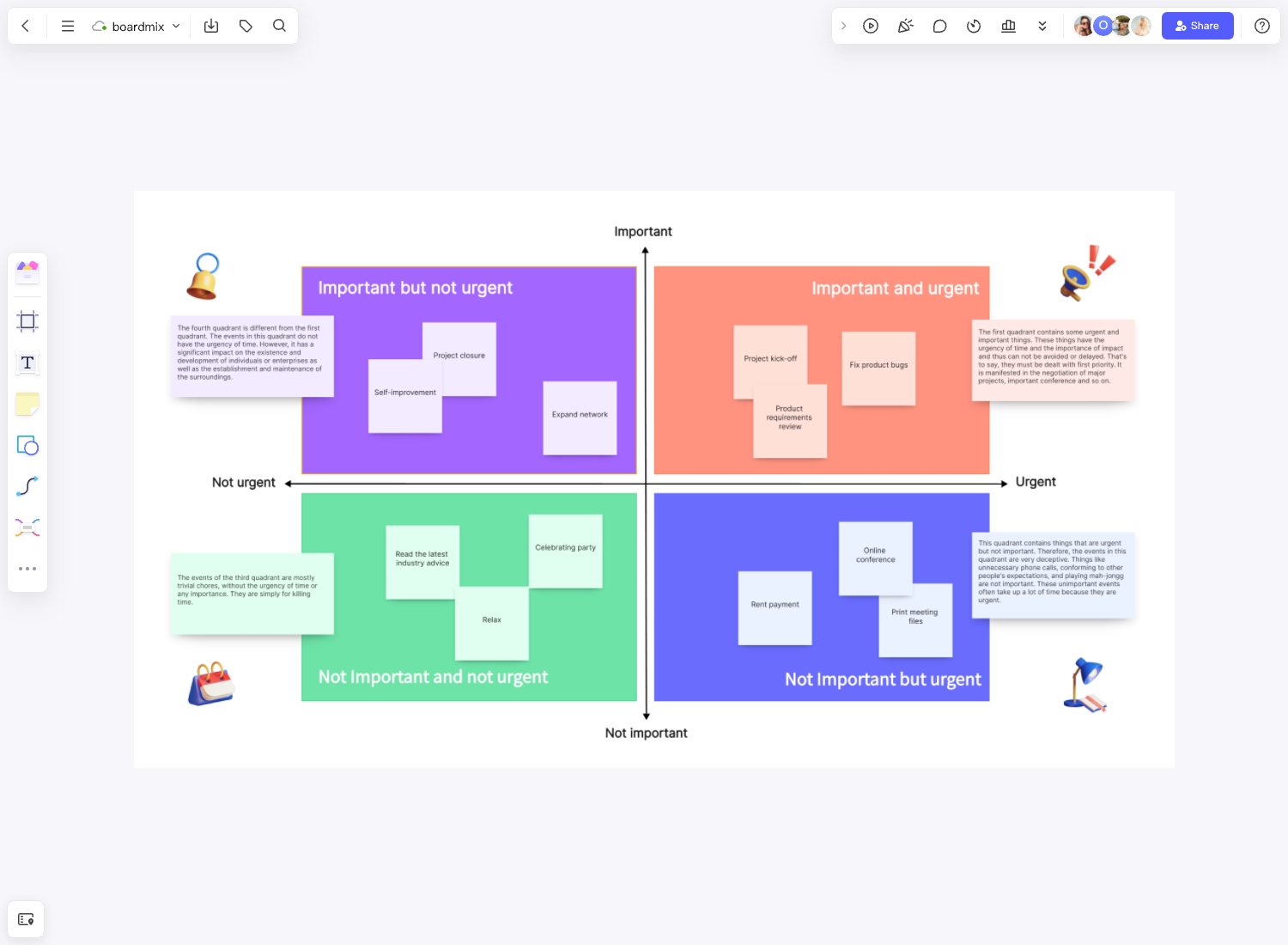About the Eisenhower Matrix Template
Explanation of the Eisenhower Matrix
The Eisenhower Matrix is a simple tool designed to help you organize your tasks and know which ones to prioritize. It is named after former US president Dwight D. Eisenhower, who said in a 1954 speech that his problems fell into either of two types – urgent and important.
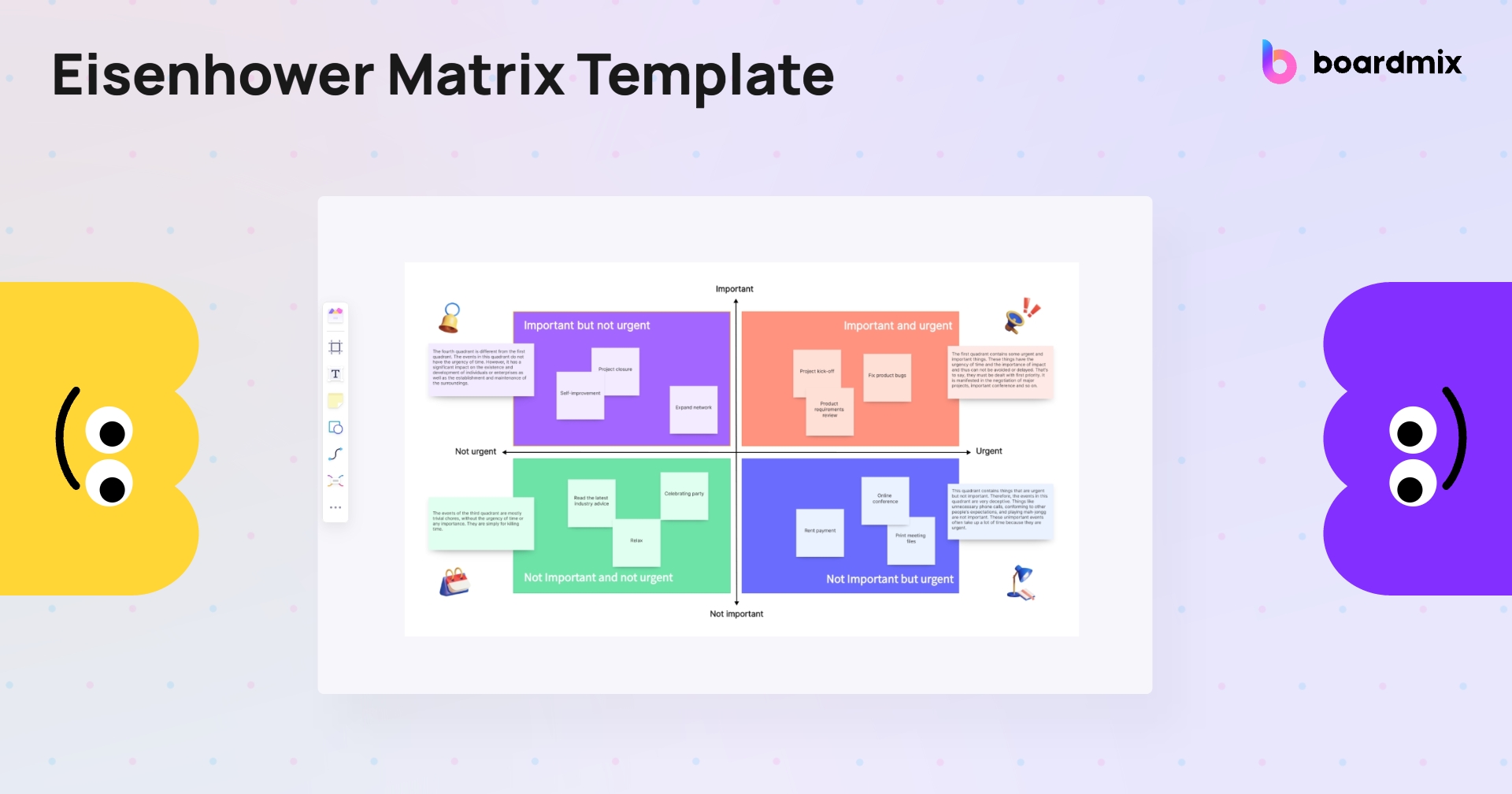
This system is practical for both professional and personal purposes. Each task is ranked according to importance and urgency and placed in its corresponding area in the matrix. Whether you are spearheading a massive corporate project or just trying to get through your day-to-day chores, an Eisenhower Matrix template will come in handy.
Importance of Eisenhower Matrix
It happens so often in our busy lives that we get overwhelmed by our list of things to do. Many times, that list seems to be getting longer instead of shorter, regardless of how much you have already done. The Eisenhower Matrix makes it easier to sort your tasks so that you can accomplish more and better manage your time.
Basic Principles of Using and Implementing the Eisenhower Matrix
No matter what kind of Eisenhower matrix template you follow, there are six basic principles that you should always take into consideration as you sort through your tasks and plug them into the matrix.
- Tasks that fall into the urgent categories must be completed right away. Postponing them is not an option.
- Important tasks, whether urgent or not, must be done well because they have a considerable impact on you or your organization.
- Tasks that are urgent and important must be completed by you and no one else.
- Tasks that are urgent but not important must be delegated to others, while you work on the urgent and important tasks.
- Tasks that are important but not urgent must be planned and implemented carefully and thoroughly. Take time to ensure that they are done well so that you can get the best possible results.
- Tasks that are not important and not urgent can be shelved for later since they do not have much impact on you or your organization.
How to Use the Eisenhower Matrix
The Eisenhower matrix template consists of four quadrants that contain tasks according to urgency and importance. To use this system, you must start by listing down all your tasks. Go through them one by one and determine to which quadrant they belong.
Four Quadrants of the Eisenhower Matrix
Quadrant 1: Important and Urgent Tasks
Tasks that have urgent deadlines and that are impacting the rest of the project significantly belong to this quadrant. In other words, these are short-term but crucial tasks that deserve your immediate and focused attention.
Quadrant 2: Important but Not Urgent Tasks
This quadrant contains tasks that don’t necessarily need to be done right away but require a lot of careful planning. You might do them on your own or you might enlist the help of other members of your organization, depending on the nature of the particular task.
Quadrant 3: Urgent but Not Important Tasks
Since they are urgent, these tasks need to be completed right away. But since they are not important, you don’t necessarily have to spend your own time on them. Instead, you can delegate this quadrant to other members of your team, but make sure that they finish the tasks as soon as possible.
Quadrant 4: Not Urgent and Not Important Tasks
In any project, there are always tasks that are not important and not urgent, yet are part of the to-do list. The Eisenhower matrix lets you easily identify these tasks specifically so that you won’t have to waste your time and effort on them. Tackle these tasks only when all the others have been completed.
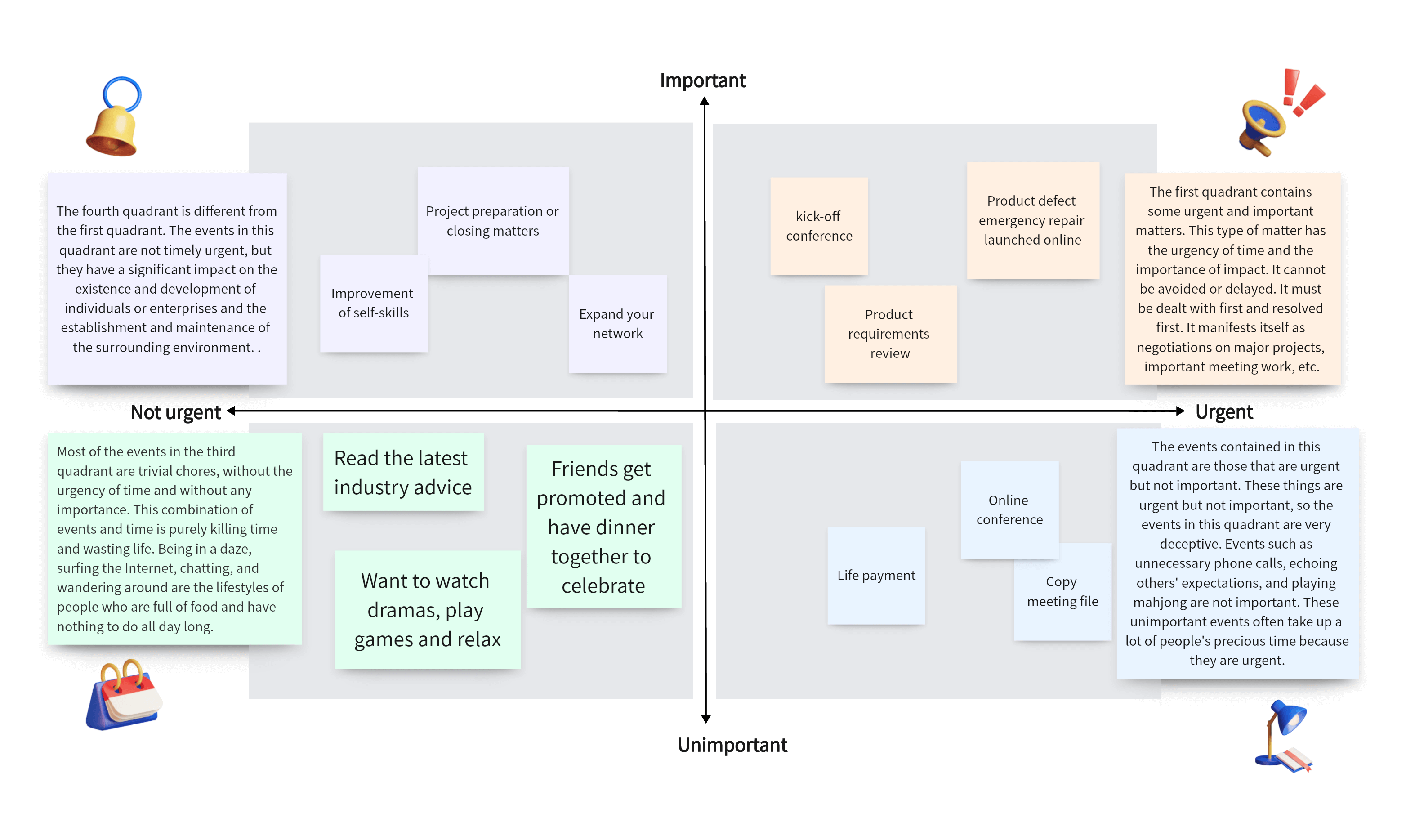
Prioritizing Tasks for Maximum Efficiency
Once you have sorted each task in your master list into the appropriate quadrant, your priorities will follow naturally. Quadrant 1 and Quadrant 2 tasks get the earliest priority because of their high-urgency requirements. Quadrant 3 gets the highest time allocation priority because you need to work on them the most. Quadrant 4 gets the least priority across all aspects.
Examples of Using the Eisenhower Matrix in Personal and Professional Settings
Eisenhower Matrix Example for a Project Manager
A project manager usually has several concurrent tasks that seem to be equally important. With the matrix above, they can easily identify which tasks to do first, which ones to delegate, which ones to schedule for a later time, and which ones to delete from the to-do list.
Eisenhower Matrix Example for People Who Work from Home
Achieving the perfect work-life balance is a huge challenge for those who work remotely from home. While it is generally not advisable to combine personal and professional tasks in a single Eisenhower matrix, the remote worker is an exemption to the rule. In this case, prioritizing tasks through the matrix helps you get more work done, both at work and in your personal life.
Benefits of Using the Eisenhower Matrix
It is easy to see that an Eisenhower matrix template would help someone who is often swamped with tasks or is frequently finding it hard to meet deadlines. Here are some specific benefits you can enjoy.
Increased Productivity
This method encourages you to focus on one task at a time, starting from the most important and urgent ones, instead of being distracted by so many other tasks of lower priority. This ultimately increases productivity and work efficiency.
Reduced Stress and Anxiety
The organized categorization of tasks made possible by the Eisenhower matrix template makes for simple visualization instead of a cluttered to-do list, which only adds stress to your already hectic schedule.
Improved Time Management
The Eisenhower matrix template promotes efficient scheduling and appropriate delegation of work, ultimately resulting in better time management and allocation.
Increased Focus on High-Priority Tasks
Without using an Eisenhower Matrix template, it is very easy to be distracted by not-so-important tasks that might be well within reach or easier to accomplish. But if you follow the matrix, your concentration will be on the more critical tasks that have a greater impact on you or your company.
Drawbacks of Using the Eisenhower Matrix
Despite the many benefits, there are a few instances where the Eisenhower matrix might do more harm than good. Here are some of the possible drawbacks that you should think about.
Potential Oversimplification of Task Prioritization
Once you sort your tasks using the Eisenhower matrix, everything seems black and white, cut and dried, absolute. But we all know that it's not always that simple in real life. An urgent and important task might be dependent on another task that has been deemed non-urgent, which would immediately present a problem in the matrix.
Difficulty in Determining the Level of Importance or Urgency of a Task
In many cases, there are plenty of overlapping categorization factors just to determine which task is more urgent or more important than the others. Some tasks might be more important than they seem, and erroneously end up in a lower-priority quadrant in an Eisenhower matrix template.
Potential Limitations on Creativity and Flexibility of Thinking
The matrix requires you to sort your tasks into boxes, so to speak. This contradicts the practice of thinking outside the box, which might be crucial to delivering a much more fruitful overall outcome.
Steps Guide to Create an Eisenhower Matrix in Boardmix
Here's a step-by-step guide on how to create an Eisenhower Matrix in Boardmix. By following these steps, you can easily create an Eisenhower Matrix in Boardmix to prioritize tasks, manage your time effectively, and make informed decisions.
1. Log in to your Boardmix account or create a new account if you don't have one already.

2. Once you're logged in, click on the "Create New Chart" button or a similar option to start creating your Eisenhower Matrix.
3. Choose a template or start from scratch: Boardmix offers various templates for different types of matrices, including the Eisenhower Matrix. You can choose the Eisenhower Matrix template to get started.
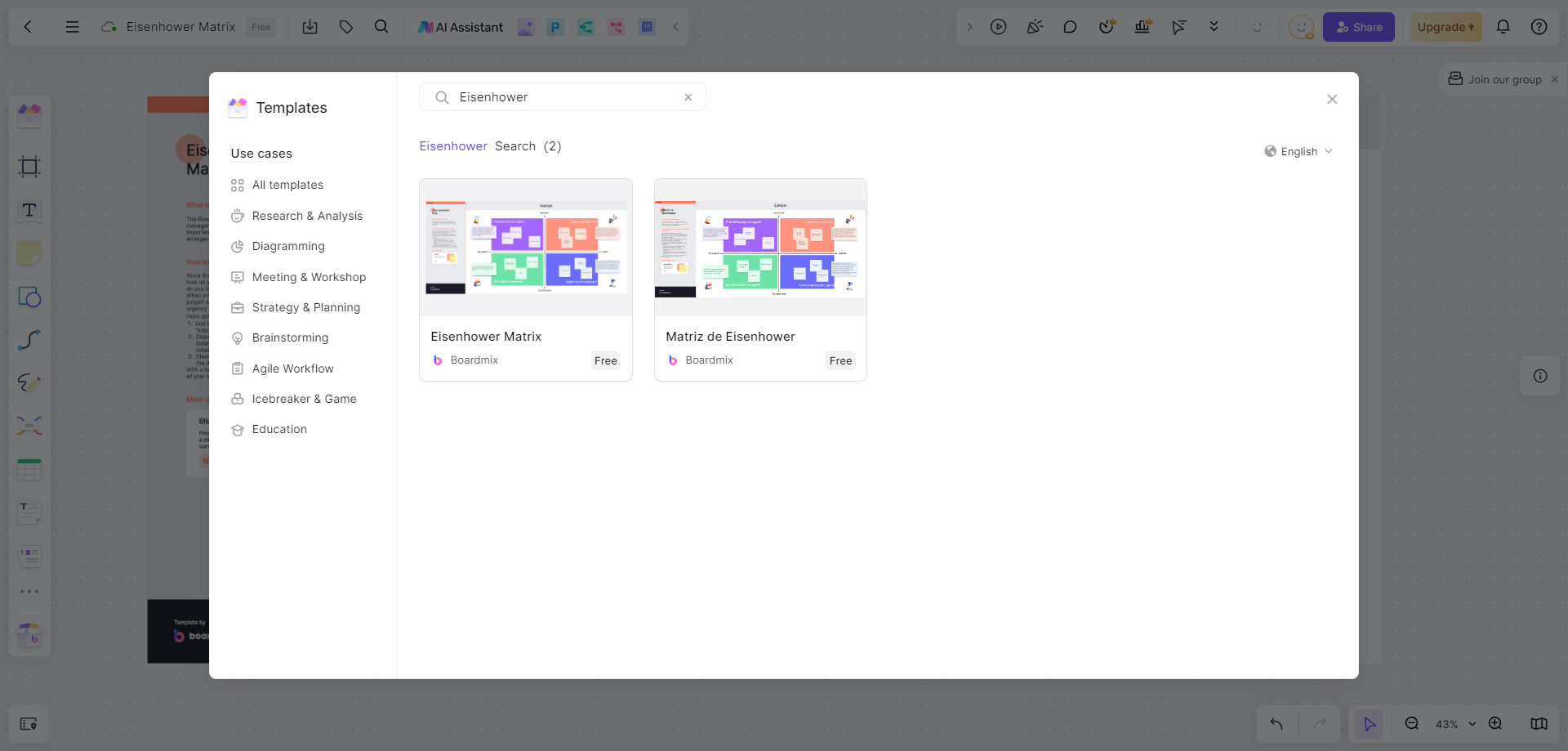
4. Define the quadrants: The Eisenhower Matrix consists of four quadrants: Urgent and Important, Important but not Urgent, Urgent but not Important, and Not Urgent and Not Important. Assign each task or item to one of these quadrants based on its urgency and importance.
5. Add tasks or items: Input the tasks or items that you want to prioritize and categorize in the Eisenhower Matrix. Each task should be represented as a separate row or column in the matrix.
6. Evaluate and prioritize: Assess each task based on its urgency and importance and assign priorities accordingly. You can use a numerical scale, such as 1 to 4, or customize the priority system based on your needs.
7. Customize the matrix: Boardmix provides various customization options to make your Eisenhower Matrix visually appealing and easy to understand. You can change the colors, and font styles, add icons or images, and more.
8. Analyze and take action: Once you have completed prioritization and customization, analyze the matrix to identify tasks that require immediate attention, those that can be delegated, those that can be scheduled for later, and those that can be eliminated or postponed.
9. Share and collaborate: Boardmix allows you to share your Eisenhower Matrix with others for collaboration and feedback. You can invite team members or stakeholders to view or edit the matrix, depending on your preferences.
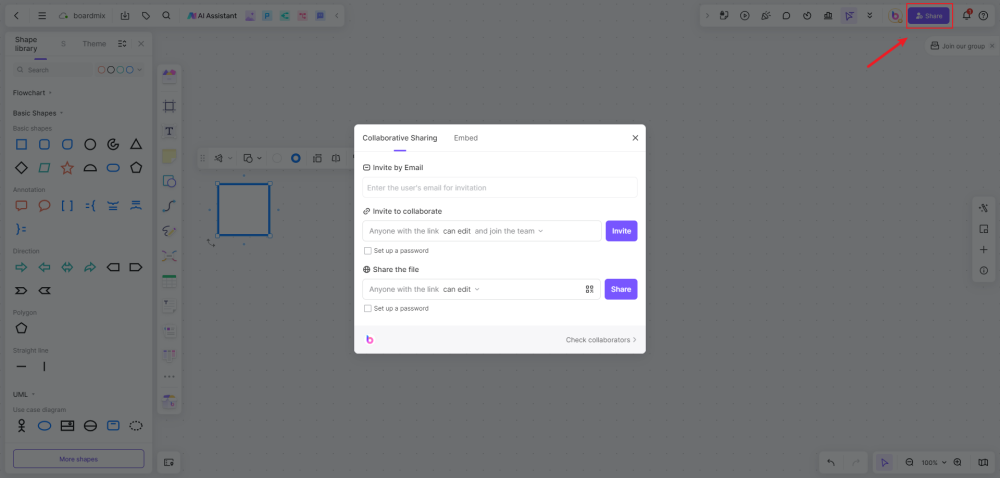
10. Review and update regularly: The Eisenhower Matrix is a tool for effective task management and prioritization. It's important to review and update the matrix regularly to reflect changes in priorities and ensure that tasks are being addressed on time.
Alternatives to the Eisenhower Matrix
There is no question as to the efficiency and innovation brought by the Eisenhower method. But in case the implementation is not suitable for a certain situation, there are a couple of alternatives that you can use.
The Covey Quadrant System
The basic principle of the covey quadrant system is very similar to the Eisenhower method. However, the biggest difference is that the focus of the Covey matrix is on the amount of time allocated for the tasks in each of the quadrants.
Thus, the first quadrant, which contains urgent and important tasks, must be done right away but must not take too much time. The quadrant with urgent and non-important tasks must also be done immediately but not by you, since they are not very important. Important but not urgent tasks must be allocated the most time because they need thorough planning. The least amount of time, if any at all, should be given to tasks that are neither urgent nor important.
The ABCDE Method
We mentioned earlier that the Eisenhower matrix might present some difficulties in determining which tasks are more important than others. A good alternative to use in these situations would be the ABCDE Method by Brian Tracy.
This method requires you to first go through your list of tasks, rating each major task by priority, from A to E. Each of these major tasks will then have subtasks that you will rank by number. Keep going through your list of tasks until each of them has an assigned number or letter.
Personalized Task Management Systems
For people on the go or those who are too swamped to use a conventional Eisenhower matrix template, there are now plenty of personalized task management systems that you can download online. Some of these are free and some are paid. Most of them are available on mobile, which means you can get access to your to-do list wherever you are.







